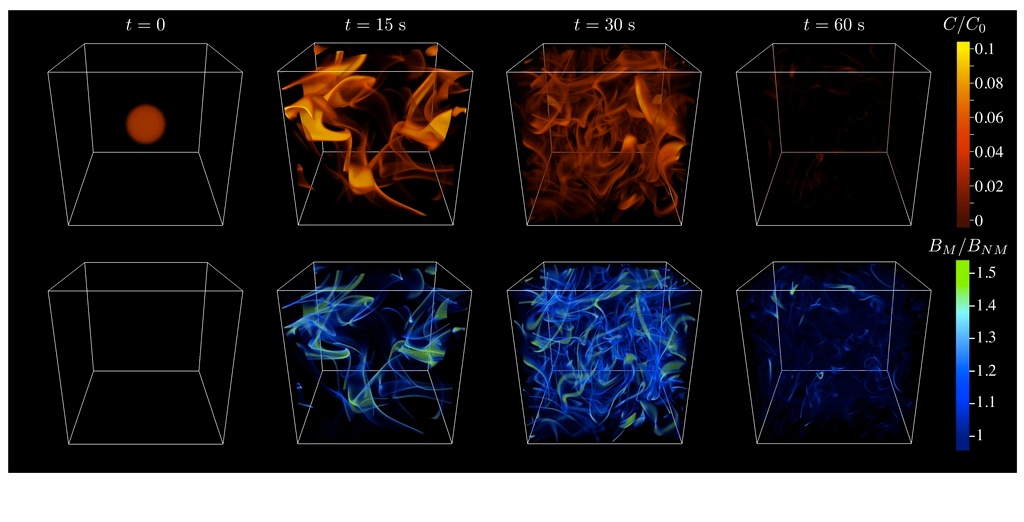Data Analysis Services Group - November 2012
News and Accomplishments
John Taylor, of Cambridge University, provided this image generated by VAPOR, and appearing in the November 2 issue of Science.
VAPOR Project
Project information is available at: http://www.vapor.ucar.edu
TG GIG PY6 Award:
XD Vis Award:
Efforts to integrate prototype depth peeling support into vaporgui, which enables the display of semi-transparent objects without prohibitively expensive visibility sorting, continued, and are expected to be completed in time for the production release of VAPOR 2.2.0. However, due to a number of outstanding bugs a decision was made not to included depth peeling in release candidate #1.
Work was also started to integrate numerous probe rendering enhancements into the VAPOR trunk code.
John worked with LLNL's Hank Childs to complete efforts to develop and test a parallel VDC reader for the DOE's VisIt application.
KISTI Award:
The end of the period of performance for the Year Two KISTI contract occurred in the month of November. All project milestones were met, and a final written report was submitted to KISTI. We are currently preparing an SOW for a third year of funding (which will need to be approved by KISTI's oversight body), and are making arrangements for two Korean graduate students to visit NCAR for a two month stay starting in January.
Development:
Release candidate 1 of VAPOR version 2.2.0 was completed and made available to friendly users on Nov. 30. The timing of the release coincided with promised deliverables for the Year Two KISTI contract. Efforts to prepare RC1 included:
- Alan spent several days making changes to the VAPOR Windows build so that the new release candidate will be installable by our KISTI collaborators (who are usually on Windows). All of our third-party libraries needed to be rebuilt, to agree with the versions we are using on Mac and Linux; and, because of Qt changes, all these needed to work in the new Windows VS2010 runtime. Most of these changes worked well, however the NetCDF library had several problems. Alan worked with members of the NetCDF team at Unidata to resolve these problems; however at this point, due to NetCDF bugs, our Windows command-line utilities can only read 4G files, and we still do not have a working 64-bit NetCDF on Windows.
- The volume rendering of spherical grids, which was broken with the move to the new RegularGrid based internal data model, was re-enabled. An additional benefit of the new internal data model is that spherical grids can now be visualized not only with the volume renderer, but also all other supported rendering engines (e.g. flow, probe, hedge hog plots, etc.)
- Numerous bugs (over 20) were fixed.
To facilitate conversion between netCDF data and VAPOR's VDC a new command line utility, ncdfvdfcreate, was developed to automate the generation of .vdf files in a manner analogous to the extant wrfvdfcreate and momvdfcreate command line tools. The new utility is built upon the previously developed NCDFCollection class object, which provides simplified access methods for operating on a collection of netCDF files that represent a model output time series. Moreover, the existing ncdf2vdf and vdfcreate utilities were refactored to use the NCDFCollection class object, which among other benefits reduces redundant code and helps provide a more consistent set of user command line options.
We continue to respond to queries on the VAPOR mailing list, and to post and fix bugs.
Administrative:
John participated in the two-day CISL strategic planning retreat in Estes Park.
Education and Outreach:
- The entire VAPOR team attended Hank Child’s talk at NREL, where he talked about problems and (possible) solutions associated with visualizing Petascale and Exascale data.
- Final arrangements were made for the upcoming 3rd annual AGU workshop on visualization to be hosted by DASG: https://wiki.ucar.edu/display/dasg/AGU+Fall+Meeting+Workshop
- John attended SC12 in SLC.
Software Research Projects
Feature Tracking:
Climate data compression:
ASD Support
Due to the instability of Yellowstone a decision was made to not require awardees to produce a representative visualization of their work in time for SC12. Nevertheless, progress was made with some of the participants:
- Alan worked with Baylor Fox-Kemper and Peter Hamlington to produce an animation of their preliminary ASD results, to present at Supercomputing.
- Alan with Gabi Pfister and Michael Burek to get an animation of Gabi’s data that was visualized in Google Earth, in time for Supercomputing.
- John worked with NCAR's David Richter to produce a "first look" animation of wind induced seawater particle spray in time for SC12
Production Visualization Services & Consulting
- Worked with Janice Coen to produce an animation of a wildfire for Supercomputing and other audiences. This utilized our new keyframe animation capabilities and her sponsors were very pleased with the results.
- Mel Shapiro is working to get a simulation of Hurricane Sandy, and has approval for a session at AMS 2013 where we will show such a visualization
- Alan visualized Hsiao-Ming Hsu’s simulation of a dust storm in the Sahara. Using 3D vis we were able to understand some unusual shapes to the dust clouds, resulting from the dust cloud being bifurcated as it passed over a mountain range.
Publications, Papers & Presentations
- xxx
Systems Projects
File System Space Management Project
- xxx
Accounting & Statistics Project
- xxx
Security & Administration Projects
- xxx
System Monitoring Project
- xxx
NWSC Planning & Installation
- xxx
System Support
Data Analysis & Visualization Clusters
- xxx
GLADE Storage Cluster
- xxx
Data Transfer Cluster
- xxx
Lynx Cluster
- xxx
Other
- xxx
